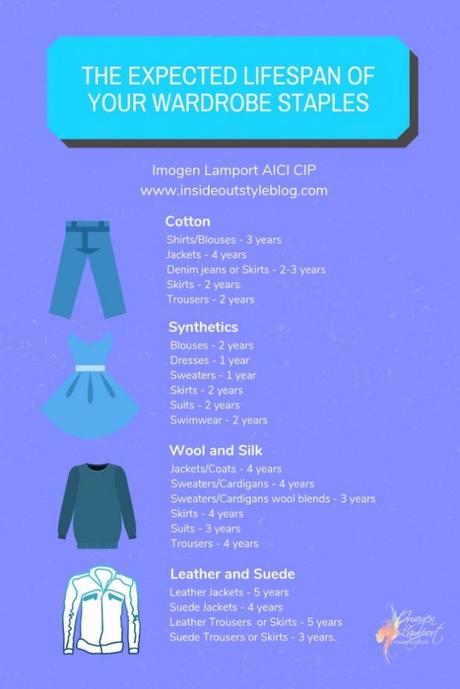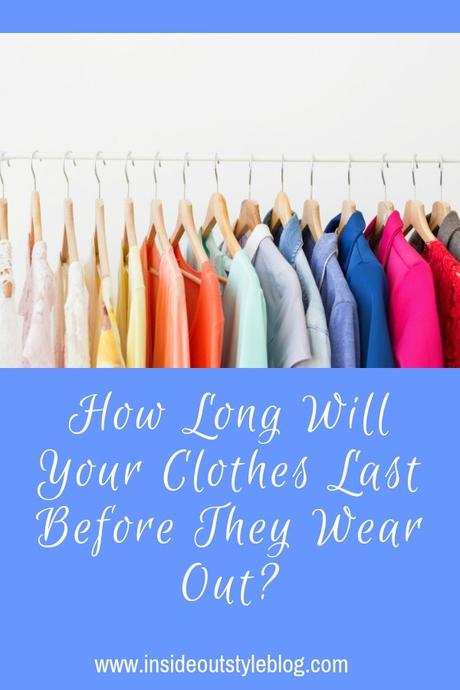One question that popped up for me (and is something I'm asked about) when I wrote about the expected fashion lifespan of your wardrobe staples here, is how long can you expect a garment to really last - as far as it still looking good and wearing well - how long will your clothes really wear well, and can you expect to keep them.
Of course, just like the question on fashion lifespan, this is a bit of a "how long is a piece of string" question, as there are a whole lot of other things that will impact on the final number such as:
- How often do you wear the item
- How often and by what method do you clean the item
- How rough are you on your clothing
- How well the garment was made in manufacturing
- Quality of the fabric (there are higher and lower quality cotton, wool, and cashmere etc.)
Now according to the dry cleaners and the International Textile Fair Claims Consumer Guide - there are some average life expectancy rates based on "normal wear and tear" (no idea what that actually is though!). The truth is, clothes that are worn frequently will wear out faster than those that are rarely worn. Simple really, so if you wear a small capsule of clothes, your clothes will wear out faster than this list (most likely), but if you have a larger range of clothes you wear, it may take longer than the 'average' life expectancy.
Average Life Expectancy of Your Clothes

What you can see is that, on the whole, natural fibres last longer than synthetics which is why purchasing clothing made from higher quality natural fibres or fibre blends is a good investment in the longer run, as they will last longer.
Sadly price doesn't always = quality, but generally, there is a relationship between a higher price and a better quality as corners are not being cut to get the item into the store for the lowest possible price.
In my experience of looking through wardrobes and seeing what doesn't wear well compared to what does, there is always a big difference in the quality of the fabrics and fibres.
What Does Wear Well
Merino wool - look for the Woolmark logo which is an indication of a higher quality merino - merino wool is a longer fibre wool, which is why it doesn't pill as easily as cheaper wools which have shorter staple fibres (each of those ends of the wool stick up - making you itchy, and rubbing and creating the little pill balls on your clothing).
Cashmere - again, look for a higher quality - a four-ply cashmere will wear better than a thinner two-ply. If it feels really soft upon purchase, it's probably been washed which gives it more softness but this overwashing causes it to be more fragile and pill easily. Good kinds of cashmere may pill - but only once - as that pill is a sign of any shorter fibres being shed, once they have been removed the pilling should stop.
Tightly spun fibres - whether cotton, linen, wool or cashmere - the tighter the fibre has been spun the less likely it is to pill.
What Doesn't Wear Well
Wool and Polyester Blends - synthetic fibres like polyester pill, but because of the plastic nature of the polyester, you can't remove the pills and you are more likely to snag and tear the garment trying to remove the pills.
Polyester - It's tough but pills easily, and the pills stay attached, so you can't remove them from the fabric without pulls and snagging.
Fibre Blends of 3 or More Different Fibres (even if they are all natural fibres) should be avoided as they will pill more quickly.
Acrylic - this has to be my number 1 waste of money fibre. It pills so quickly (it has really short staple fibres) and looks cheap and old fast - seriously - in just a few wears, I've seen acrylic items in wardrobes that look old and pilled when they are only 3 weeks old!
What to Look for When Purchasing
How do you know if a garment is going to wear well? This can be tricky - so here are some tips to help you.
How does it feel? With knits and wovens if they feel think, brittle or rough it's not worth the money. It should feel smooth, soft and substantial as this means there is more fibre in the knit, which makes it last longer. Look for fabrics that have tightly packed yarns rather than loosely knitted (as these will also snag really easily). With wool - put it against your neck - the less itchy it feels the longer the fibres are - so the better it will wear.
Stretch it. If it's a knit the fabric should bounce back - if it doesn't, then it's going to get saggy and baggy pretty quickly!
Is it strengthened with interfacing? Are the collars and cuffs, the waistbands of woven shirts and trousers strengthened and stiffened with interfacing? If not they will not wear well and will become misshapen quickly.
Check the seams. The longer the stitch the more likely you are to get holes in the seams. If the seams are sloppy it's poorly made. If you can see where they have run out of thread then started again this is a warning sign to leave it in the store. If threads seem loose when it's brand new, it's not going to improve with age! If a thread is flat on the surface but bubbling up underneath the tension of the stitch isn't balanced and the seam won't be stable and will wear quickly. The crotch on a pair of jeans or trousers should be sewn twice for extra reinforcement.
Look at the buttonholes. No fraying threads, lots of cotton threads sewn tightly together, not few stitches further apart which makes the buttonhole flimsy.
Turn it inside out. Notice how well the inside of the garment is finished. If it looks clean and finished as the exterior, it's made with more care and attention to detail which means it should last longer.
Look in Your Closet at What Has Worn Well
Research what you own that has worn well - look at the fibre content and note down what it is. Hold it up to the light - see how tightly knitted or woven it is. Notice if the fibres look tightly spun or loosely spun. Stretch the fabric and see how it bounces back. Check out the seams and see how they are constructed.
Getting to know garments and the fabrics they are made from and how they have worn means you know what to look for when buying new.
Caring For Your Clothes
The more you launder the faster your clothes will wear out. Dyes leach and fade out. Fabrics stretch and shrink. The dryer is the worst piece of time-saving laundry equipment for your clothing as you are heating the fibres (and so make them more likely to shrink and if it's a blended fabric, different fibres will shrink at different rates), the lint you clean from your dryer? Well, that's your clothes being worn out by it. If you can hang your clothes to dry, they will last longer than if you put them in the dryer. We installed a drying cupboard in our laundry and it's been a great investment, particularly in winter when clothes don't dry outside.
Check the care label on your clothing item - if it says to wash inside out, this is to help prevent fading, or to protect decorative elements on the fabric.
Synthetics such as nylon don't perform well in heat - so if it's a nylon blend - be aware that the nylon will not stay stable in the dryer and you're more likely to get a misshapen garment after laundering this way.
A front loading washer with a delicates cycle is fairly equivalent to a handwash. Top loaders, because of the agitator in the middle, are always rougher on fabrics.
Use laundry bags for delicate items so they don't snag on other things in the wash.
Cool water and gentle washes will keep items looking fresher for longer too.
More Tips
The Expected Fashion Lifespan of Your Wardrobe Staples and How to Identify Fads, Trends and Classics
Sustainable Fashion Resources To Help You Make the Best Fashion Buying Decisions



